It represents Japanese Sushi culture - Tuna. Not only for Sushi, but also as tuna cans, they are very important fishery resource. Huge body (over 2m!) and thier mysterious ecology attract researchers. On the other hand, the resource management of tuna bacame one of the big issues in international corporation, because of the remarkable decline in catch. Our lab researches tuna's migration ecology by archival tags, especially focusing on albacore, Pacific bluefin and yellowfin tunas. For analysis of environmental fluctuation effect on tuna resources, chemical analysis of eggs, larve and otoliths are also notable.
1. Pacific Bluefin Tuna (Thunnus orientalis) - Migration Ecology
Pacific bluefin tuna is one of the top commercial target fish by its high quality meat (Picture 1). Catch reaches over 10,000 tons in Japan. However, the catch has been in decline since 1970s. As the primary market of bluefin tuna, proper resource management is an quite important issue for us. Their highly migratory ecology requires international management scheme, and it needs more detailed analysis of their migration mechanism. We use archival tags (Picture 2) for bahavior analysis of tunas. Our goal is to find out how bluefin tuna adapted to temperate water by measuring migration behavior of young tunas in the North Pacific. The measurements include environmental and physiological conditions of sample, and physical and biological factors influencing their migration behavior.
Our research revealed that Pacific bluefin tuna in the East China Sea has circadian cycle in vertical migration; stay in the mixed layer around the surface at night in winter, and moved to deeper water in day time (Figure 1). Some individuals migrated to far off Nansei Shoto region, where water temperature stratification was observed. Their circadian cycle was especially significant, thus stratification seems to be a que for the cycle. On the other hand, individuals that moved to offshore of Sanriku stayed in warm-eddy (Picture 3). In this region, stratification was relatively weak, and tunas have tendency to stay in the surface layer and less divings compare to individuals in the East China Sea. Besides, feeding frequency was calculated by detecting body temperature drops following swallow of food. The analysis indicates indiciduals of offshore of Sanriku fed more often in day time compared to individuals of the East China Sea. This results revealed that this species changes feeding strategy based on the area; below thermocline in the East China Sea v.s. horizontal searching in offshore of Sanriku (Figure 2-1 & 2-2). Archival tags brought detailed data for understanding their ecology. Spacial and Seasonal change of water temperature and stratification have strong influence to vertical migration of Pacific bluefin tuna.
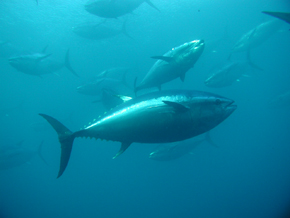 |
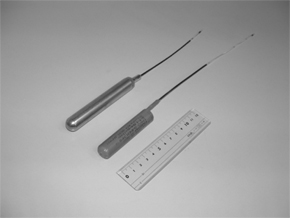 |
| Picture 1. Migration of Pacific Bluefin Tuna | Picture 2. Archival Tag |
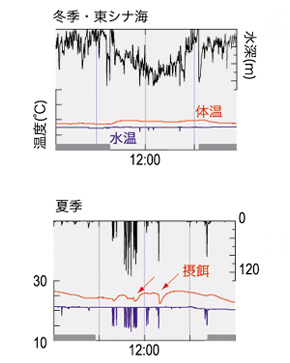 |
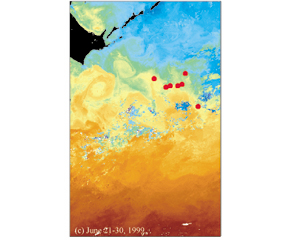 |
| Figure 1. Swimming Depth of Pacific Bluefin Tuna in the East China Sea | Picture 3. Satellite Picture of Pacific Bluefin Tuna in warm eddy, offshore of Sanriku |
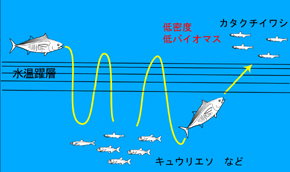 |
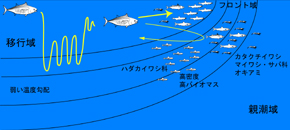 |
| Figure 2-1. Foraging in the East China Sea | Figure 2-2. Foraging in offshore of Sanriku |
2. Thermoregulation Mechanisms of Tunas
Pacific bluefin tuna has warmer body temperature than surrounding water. Also, difference between body and water temperature tends to be bigger as water temperature drops. Mathematical model indicates thermal inertia and high heat production contribution to maintain high body temperature. Calculation revealed that Pacific bluefin tuna attains thier internal heat production as high as mammals. Thus, they can maintain thier peritoneal temperature when they foaging into cold environment. On the other hand, their ability to recover the cooled body temperature to surrounding water temperature is not high (Figure 3). Because of that, they stay at the warm surface and enters into cold water when foraging. Pacific bluefin tuna manages their thermoregulation by behavior modification. Vertical migration is also affected by amount of insolation. Frequency of vertical migration decreases as the insolation decreases.
As Pacific bluefin tuna grows larger, they achieves higher body temperature compared to surrounding water. However, increase rate of temperature difference drops as their growth, and their mean body temperature do not exceed 30 degrees Celsius. Mathematical model indicated that heat-transfer rate increases and heat production speed decreases as they grow larger. Thus, the body temperature would not reach to fatal temperature. With these abilities, they can stay in temperate water and achieve huge body size, one of the maximum fish in the world.
Now, we also reserach on yellowfin tuna (T. albacares), which is large species living in tropical water, using same methods (archival tags) to reveal their migration mechanisms (Picture 4).
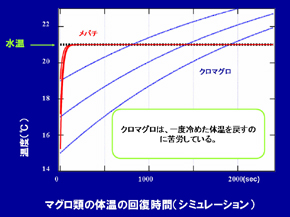 |
 |
| Figure 3. Recovery time for tunas (Simuration) | Picture 4. Attaching archival tags to yellowfin tuna |
3. Influence of Marine Environmental Fluctuation to Tunas
Pacific bluefin tuna has particular spawning area compared to their wide spreads in the Pacific ocean; Southern ocean below 30 degrees north and east of the Kuroshio. Spawning season is in May to June around Nansei islands and June to July in offshore of southern main islands of Japan, and July to August in Japan Sea. They breed in area of sea surface tempearature of 25 to 26 degree Celsius and thermocline is 50m or shallower. Compare to their distribution, the spawning area is quite limited. Thus the environmental fluctuation around the area should be tremendous for their spawning ecology. We research how marine environmental fluctuation affects the behavior and reproduction of tunas (Picture 5).
What is the influence of temperature change to eggs and larva of Pacific bluefin tuna? Culture experiments showed that the survival and growth would be affected negatively when water temperature reasches too hot or too cold. RNA/DNA ratio, exygen consumption and deformity rate of larvae also indicated the influence of sea surface temperature rise.
Besides, otoliths of Pacific bluefin tuna are now considered to be an index of marine environmental fluctuation. Oxygen stable isotope ratio of otolith can be a recorder of temperature and environmental changes. If the environmental differences in spawning grounds are recorded in otoliths, population structure of Pacific bluefin tuna can be analyzed in details. Our research can be a turning point for resource management of Pacific bluefin tuna.
Also, albacore (T. alalunga) of north Pacific were targeted for environmental factor analysis of migration ecology of tunas. Time and space structure of albacore distribution from spawning to maturity. Results showed the migration route changes when they reach 6 years old and form counter-clockwise cycle. Besides, senior individuals in central Pacifc move to east Pacifc when El Niño occures (Figure 4).
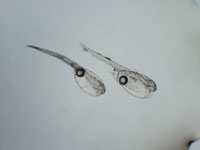 |
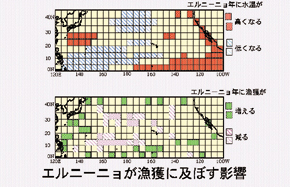 |
| Picture 5. Larva of Pacific Bluefin Tuna | Figure 4. Influence of El Niño to Albacore Catch |
References
- Kimura, S., Nakai, M. and Sugimoto, T. (1997) Migration of albacore (Thunnus alalunga) in the North Pacific Ocean in relation to large oceanic phenomena. Fisheries Oceanography, 6, 51-57.
- Kitagawa, T., Sartimbul, A., Nakata, H., Kimura, S. and Yamada, H. (2006) Effect of water temperature on habitat use of young Pacific bluefin tuna, Thunnus orientalis, in the East China Sea. Fisheries Science, 72, 1166-1176.
- Kitagawa, T., Kimura, S., Nakata, H. and Yamada, H. (2006) Thermal adaptation of Pacific bluefin tuna Thunnus orientalis to temperate waters. Fisheries Science, 72, 149-156.
- 北川貴士.(2006) バイオロギングによるクロマグロの行動生態研究の現状.テレメトリー-水生動物の行動と漁具の運動解析-.山本勝太郎,山根 猛,光永 靖編,恒星社厚生閣,45-55.
- 北川貴士.(2005) クロマグロの遊泳行動とそれに及ぼす物理環境要因.月刊海洋,6:海洋動物の認知システムと回遊メカニズム,416-421.
- 北川貴士.(2005) マグロ類の遊泳と回遊.海の生物資源-生命は海でどう変動しているか-,海洋生命系のダイナミクス・シリーズ第4巻,渡邊良朗編,東海大学出版,37-53.
- 北川貴士.(2005) クロマグロ体温と環境水温の熱交換モデル.水産工学,41,257-260.
- Kitagawa, T., Kimura, S., Nakata, H. and Yamada, H. (2004) Diving behavior of immature Pacific bluefin tuna (Thunnus thynnus orientalis) for feeding in relation to seasons and areas: the East China Sea and the Kuroshio-Oyashio transition region. Fisheries Oceanography, 13, 161-180.
- Kitagawa, T., Kimura, S., Nakata, H., Yamada, H. (2004) Overview of the research on tuna thermo-physiology using electric tags. Memoirs of the National Institute of Polar Research, Special, Issue 58, 69-79.
- Kitagawa, T., Kimura, S., Nakata, H. and Yamada, H. (2004) Effect of light intensity on the vertical movement of Pacific bluefin tuna Thunnus orientalis. Zoological Science, 21, 1258-1259.
- 北川貴士.(2004) クロマグロの遊泳行動とそれに及ぼす海洋要因.海流と生物資源,杉本隆成編著,成山堂,224-236.
- Kitagawa, T., Kimura, S., Nakata, H. and Yamada, H. (2003) Diving patterns and performance of Pacific bluefin tuna (Thunnus thynnus orientalis) as recorded by archival tags. Otuchi Marine Science, 28, 52-58.
- Kitagawa, T., Kimura, S., Nakata, H. and Yamada, H. (2003) Adaptation mechanisms of Pacific bluefin tuna to temperate waters. Zoological Science, 20, p1526.
- 北川貴士.(2003) クロマグロの日周鉛直行動とその意味ミ東シナ海で再捕されたクロマグロ未成魚の遊泳状況. アクアネット,6,(6),31-35.
- Kitagawa, T., Nakata, H., Kimura, S., Sugimoto, T. and Yamada, H. (2002) A review: Analysis of tunas behavior using of acoustic, archival and pop-up tags methods. Otsuchi Marine Science, 27, 1-6.
- Kitagawa, T., Nakata, H., Kimura, S. and Yamada, H. (2002) Diving behavior of immature Pacific bluefin tuna (Thunnus thynnus orientalis) recorded by an archival tag. Fisheries Science, 68, Supplement I, 427-428.
- Kitagawa, T., Nakata, H., Kimura, S., Sugimoto, T., Yamada, H. (2002) Differences in vertical distribution and movement of Pacific bluefin tuna (Thunnus thynnus orientalis) among areas: the East China Sea, the Sea of Japan and the western North Pacific. Marine and Freshwater Research, 53, 245-252.
- 北川貴士.(2002) クロマグロ仔稚・未成魚の温帯水域への輸送・回遊. 月刊海洋,号外31,黒潮の生物輸送と生産機能,152-157.
- Kitagawa, T., Nakata, H., Kimura, S. and Tsuji, S. (2001) Thermoconservation mechanism inferred from peritoneal cavity temperature recorded in free swimming Pacific bluefin tuna (Thunnus thynnus orientalis). Marine Ecology Progress Series, 220, 253-263.
- Kitagawa, T., Nakata, H., Kimura, S., Itoh, T., Tsuji, S. and Nitta, A. (2000) Effect of ambient temperature on the vertical distribution and movement of Pacific bluefin tuna (Thunnus thynnus orientalis). Marine Ecology Progress Series, 206, 251-260.
- 溝呂木奈緒.(2009) 地球温暖化に伴う水温上昇がクロマグロ(Thunnus orientalis)の初期生残に及ぼす影響.東京大学大学院新領域創成科学研究科自然環境学専攻,修士論文.
- 中井宗紀・木村伸吾・杉本隆成.(1994) ビンナガの回遊.月刊海洋,26,547-551.


